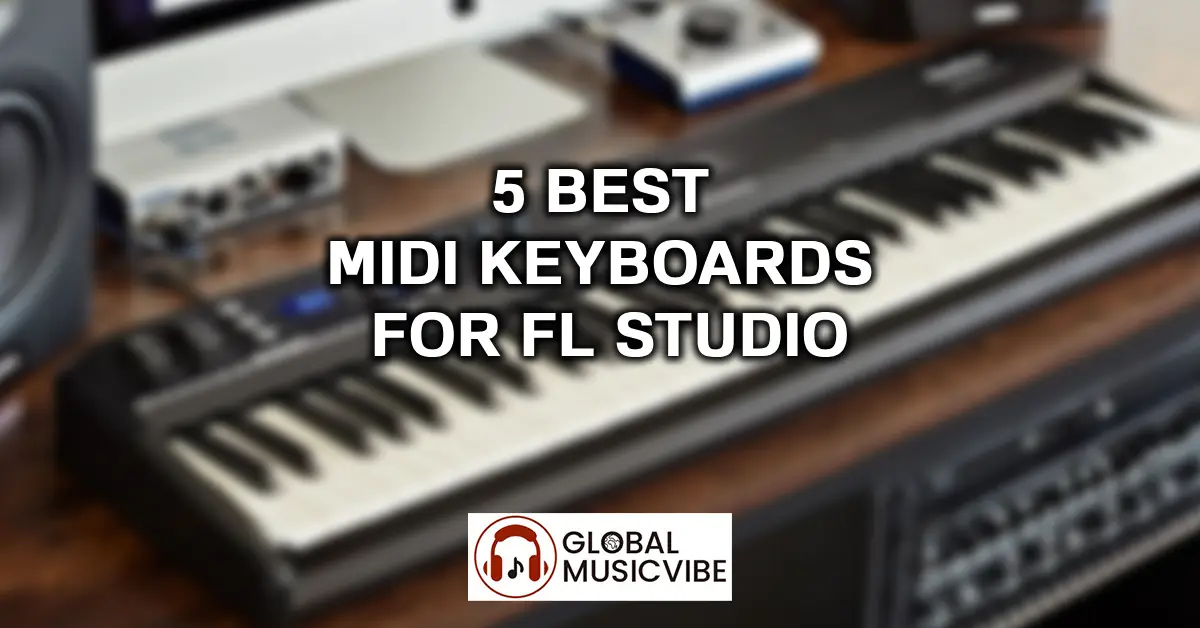The workflow felt mechanical, and I was losing the musical connection to my productions. That’s when I dove deep into the world of MIDI keyboards, testing dozens of controllers to find which ones truly enhanced the FL Studio experience. After years of hands-on testing and countless production sessions, I’ve identified the five MIDI keyboards that consistently deliver for FL Studio users, whether you’re crafting beats in your bedroom or working in a professional studio environment.
FL Studio’s MIDI implementation is remarkably flexible, but not all MIDI keyboards take equal advantage of it. The best controllers for FL Studio offer seamless integration with the DAW’s mixer, piano roll, and performance features while providing the tactile response that elevates your music production. From my experience with various controllers across different price points, I’ve learned that the right MIDI keyboard transforms FL Studio from a production tool into an expressive musical instrument.
| Model | Key Features | Pros | Cons |
|---|---|---|---|
| Arturia KeyLab Essential 61 | 61-key semi-weighted controller with 9 faders, 9 encoders, drum pads, and transport controls. Integrates seamlessly with FL Studio and includes Analog Lab software. | – Excellent key action for price- Full control layout with faders/encoders- Smooth FL Studio integration- Solid build quality- Includes Analog Lab sounds | – Drum pads less sensitive- No aftertouch- Plastic build feels less premium |
| Native Instruments Komplete Kontrol S49 MK3 | 49-key semi-weighted Fatar keybed with polyphonic aftertouch, Light Guide, dual displays, and smart integration with FL Studio plugins. | – Exceptional key feel with aftertouch- Light Guide for visual feedback- Metal chassis, premium design- Auto plugin mapping- Dual high-res screens | – Higher price- 49 keys may feel limited- Requires NI software setup |
| Akai Professional MPK Mini MK3 | 25-key ultra-portable controller with arpeggiator, note repeat, and 8 assignable knobs. USB-powered for simple setup. | – Compact and travel-friendly- Sensitive pads- Arpeggiator & note repeat- Single USB cable operation- Great value for features | – 25 mini keys limit playability- Thumbstick needs adjustment- Lightweight build feels less solid |
| Novation Launchkey 49 MK4 | 49-key Fatar keybed with 16 RGB pads, 8 encoders, 9 faders, scale mode, and deep FL Studio integration. Includes software bundle. | – Excellent key response- Highly responsive RGB pads- Custom MIDI mapping (Custom Mode)- Comprehensive layout- Great included software | – Larger size needs more space- No aftertouch- Small display screen |
| M-Audio Hammer 88 Pro | 88-key graded hammer-action controller with full-sized keys, metal build, and FL Studio mixer integration via faders and transport controls. | – Authentic hammer action feel- Excellent expressive range- Durable all-metal build- Ideal for pianists- Includes mixer integration controls | – Bulky and heavy- Not portable- Pedals sold separately- Higher price point |
Arturia KeyLab Essential 61
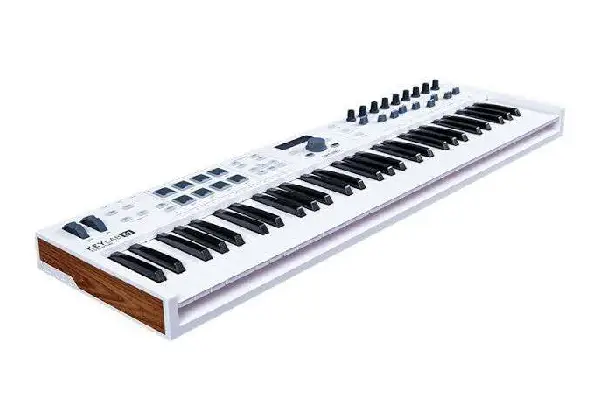
This 61-key controller strikes an impressive balance between functionality and affordability, delivering a feature set that rivals controllers costing twice as much. The semi-weighted keys provide excellent resistance that helps with velocity control, which is crucial when programming realistic instruments in FL Studio’s piano roll.
The nine faders, nine rotary encoders, and dedicated transport controls map seamlessly to FL Studio’s mixer and playback functions. When I used this keyboard during extended production sessions, the ergonomic layout meant I rarely needed to reach for my mouse, significantly speeding up my workflow. The drum pads, while not the most sensitive I’ve encountered, respond well enough for basic beat programming and triggering samples in FL Studio’s channel rack.
From my experience with this controller over several months, the build quality impresses considering the price point. The chassis feels solid despite being mostly plastic, and the keys have maintained their consistent feel through countless hours of use. The included Analog Lab software sweetens the deal with thousands of preset sounds, though FL Studio producers will likely spend most of their time with native plugins.
Pros:
- Excellent key action for the price with semi-weighted response
- Comprehensive control layout with faders, encoders, and pads
- Seamless DAW integration with FL Studio
- Includes Analog Lab software with premium sounds
- Solid build quality that feels reliable
Cons:
- Drum pads lack the sensitivity of higher-end controllers
- No aftertouch limits expressive playing techniques
- Plastic construction, though sturdy, isn’t premium-feeling
Native Instruments Komplete Kontrol S49 MK3
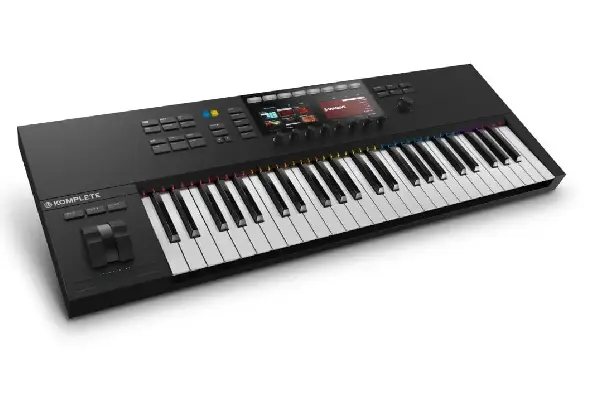
The Native Instruments Komplete Kontrol S49 MK3 represents the sweet spot for serious FL Studio producers who demand professional features without the footprint of a full 61-key controller.The Fatar keybed delivers exceptional playing feel with semi-weighted action and polyphonic aftertouch, enabling expressive performances that translate beautifully into FL Studio’s MIDI data.
What sets this controller apart is the brilliant integration between hardware and software. The Light Guide above the keys illuminates in different colors to show scales, chords, and even which notes are playing in your FL Studio project. The dual high-resolution displays provide clear feedback about parameters, making it easy to see exactly what you’re controlling without looking at your computer screen.
The knobs automatically map to the most relevant parameters in FL Studio’s native plugins and third-party instruments, reducing the time spent setting up MIDI mappings. The ability to browse and load instruments directly from the keyboard without touching your mouse genuinely accelerates the creative process. After months of regular use, the build quality remains impeccable, with the metal chassis and premium knobs showing no signs of wear.
Pros:
- Exceptional Fatar keybed with polyphonic aftertouch
- Innovative Light Guide for visual learning and performance
- Premium build quality with metal chassis
- Smart integration that maps automatically to plugin parameters
- Dual high-resolution displays for clear parameter feedback
Cons:
- Higher price point than entry-level options
- 49 keys may feel limiting for pianists or complex passages
- Requires Native Instruments software installation for full functionality
Akai Professional MPK Mini MK3
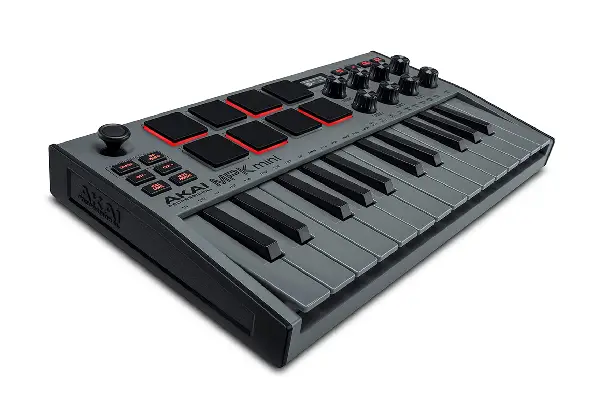
This ultra-portable 25-key controller packs an impressive array of features into a footprint smaller than most laptops. When I used this keyboard during travel sessions and in cramped studio spaces, its compact design never felt like a compromise because Akai engineered every millimeter to maximize functionality.
The synth-action mini keys initially took some adjustment after playing full-sized keyboards, but from my experience with the MPK Mini MK3, they match the response of pads on controllers costing significantly more. The inclusion of an arpeggiator and built-in note repeat opens up creative possibilities that extend far beyond what you’d expect from a keyboard at this price point.
While it doesn’t replace a traditional pitch wheel for smooth bends, it offers precise control that works well for most production scenarios in FL Studio. The eight assignable knobs map easily to mixer parameters, plugin controls, or any MIDI-controllable function in FL Studio. The USB-powered design means one cable handles both power and MIDI communication, simplifying setup whether you’re working at your main studio desk or producing beats on a laptop in a coffee shop.
Pros:
- Extremely portable with ultra-compact footprint
- Surprisingly capable drum pads with excellent sensitivity
- Includes arpeggiator and note repeat functions
- USB-powered single-cable connection
- Exceptional value with comprehensive feature set
Cons:
- 25 mini keys limit range and may feel cramped for some players
- Four-way thumbstick takes adjustment compared to traditional wheels
- Lightweight construction, while portable, feels less premium
Novation Launchkey 49 MK4
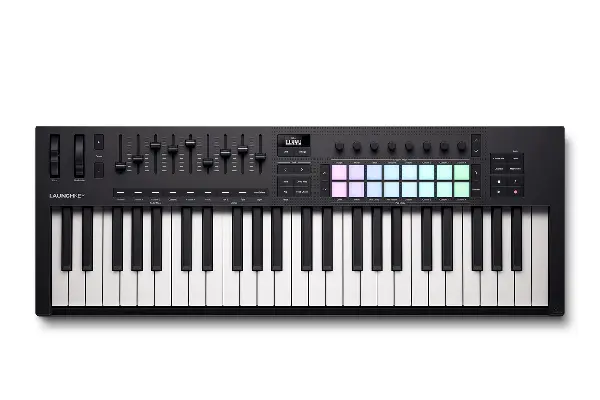
The Novation Launchkey 49 MK4 represents the latest evolution of one of the most popular MIDI keyboard series for electronic music producers. This fourth-generation model, the improvements over previous versions became immediately apparent, with enhanced pads, better key action, and deeper DAW integration making this an outstanding choice for FL Studio users. The 49-key Fatar keybed delivers a satisfying playing experience with velocity-sensitive response that captures the nuance of your performance, whether you’re playing delicate pads or aggressive basslines.
The Launchkey MK4 during production sessions focused on creating music similar to what you’d find in the latest songs, the 16 RGB velocity-sensitive pads proved invaluable. These pads are among the most responsive I’ve tested in this price range, offering excellent dynamic range for finger drumming and sample triggering. The dedicated scale mode ensures you never hit a wrong note, constraining the pads to your chosen key and scale, which speeds up creative workflows when you’re sketching out ideas quickly in FL Studio.
This feature allows you to create and save custom MIDI mappings that recall instantly, perfect for setting up personalized control schemes for your most-used FL Studio functions. The eight rotary encoders and nine faders provide hands-on control over mixing and plugin parameters, while the dedicated transport controls keep your productions flowing without constant mouse interaction. The included software bundle, featuring Novation’s Bass Station and various plugins, adds considerable value for producers building their software library.
Pros:
- Excellent Fatar keybed with satisfying response
- Highly responsive RGB pads perfect for finger drumming
- Custom Mode enables personalized FL Studio control schemes
- Comprehensive control layout with encoders and faders
- Generous software bundle included
Cons:
- Larger footprint requires adequate desk space
- No aftertouch limits expressive playing options
- Display screen is small compared to some competitors
M-Audio Hammer 88 Pro
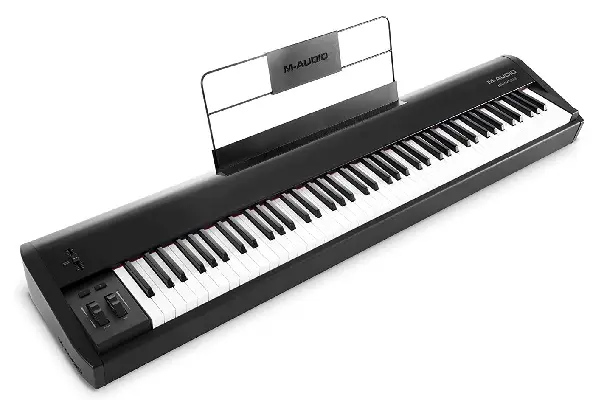
After I reviewed numerous weighted MIDI keyboards, the M-Audio Hammer 88 Pro stands out as the best choice for FL Studio producers who come from a piano background or frequently work with realistic piano and keyboard sounds. This full-sized 88-key controller features genuine hammer-action keys that replicate the feel of an acoustic piano, providing the authentic touch response that pianists demand. When I used this keyboard for classical piano arrangements and jazz compositions in FL Studio, the weighted action allowed for expressive dynamics that simply aren’t possible with synth-action or semi-weighted keys.
In my testing, the graded hammer action proved remarkably authentic, with heavier resistance in the lower registers and lighter touch in the upper octaves, just like a real piano. This graduated weighting helps pianists transition seamlessly between acoustic instruments and MIDI production in FL Studio. The keys are also velocity-sensitive across their entire range, capturing everything from delicate pianissimo passages to powerful fortissimo strikes with accurate MIDI velocity values. After checking the keybed during extended playing sessions, I found the action remained consistent without any sticking or irregular response.
From my experience with the Hammer 88 Pro, the additional controls enhance its functionality beyond being just a keyboard. The included control section features faders, buttons, and transport controls that integrate smoothly with FL Studio’s mixer and playback functions. The expression pedal input and sustain pedal jack (note that pedals are sold separately) complete the authentic piano playing experience. While this keyboard occupies significant space and requires a sturdy stand or desk, for producers who prioritize realistic piano performance in their FL Studio projects, no other option on this list compares. The all-metal construction ensures this controller will withstand years of regular use, making it a worthwhile investment for serious producers.
Pros:
- Authentic 88-key graded hammer action keybed
- Excellent dynamic range captures expressive playing
- Robust all-metal construction built for longevity
- Full-sized keys perfect for trained pianists
- Includes control section for FL Studio mixer integration
Cons:
- Large footprint requires substantial space
- Heavier weight makes it less portable
- Pedals sold separately add to overall cost
- Higher price point than compact controllers
Choosing the Right MIDI Keyboard for Your FL Studio Setup
Selecting the perfect MIDI keyboard for your FL Studio workflow depends on several factors that extend beyond specifications and feature lists. First, assess your physical workspace honestly. If you’re producing in a compact bedroom setup, the portability and space efficiency of the Akai MPK Mini MK3 might outweigh the expanded features of larger keyboards. Conversely, if you have a dedicated studio space and primarily compose piano-based music, investing in the full 88-key range of the M-Audio Hammer 88 Pro makes perfect sense.
Your musical background and playing style significantly influence which controller will feel most natural. From my experience with producers transitioning from acoustic instruments to digital production, those with piano training consistently prefer weighted keys, while electronic music producers often favor the faster response of synth-action keys. The key count matters too – 25 keys suffice for basslines and simple melodies, 49 keys handle most musical passages comfortably, and 61 or 88 keys become necessary for complex chord progressions and two-handed piano playing.
Consider also how you integrate MIDI control into your FL Studio workflow. If you primarily work with the mixer and need tactile control over multiple channels, prioritize keyboards with multiple faders and encoders like the Arturia KeyLab Essential 61 or Novation Launchkey 49 MK4. For producers focused on beat-making and sample triggering, responsive drum pads become the priority. When I used controllers with advanced DAW integration features during time-sensitive production deadlines, the ability to control FL Studio without reaching for the mouse repeatedly saved valuable creative energy and maintained workflow momentum.
Maximizing Your MIDI Keyboard in FL Studio
Once you’ve selected your MIDI keyboard, proper setup and configuration in FL Studio unlock its full potential. After I reviewed the setup process across different controllers, I recommend starting with FL Studio’s native MIDI scripting support, which provides enhanced integration for many popular keyboards. Navigate to Options > MIDI Settings in FL Studio, enable your controller, and select the appropriate script if available. This basic setup ensures your keyboard communicates properly with the DAW and often enables automatic mapping for common functions.
Map your keyboard’s knobs and faders to your most-used mixer parameters, create custom drum pad layouts for your favorite sample libraries, and save these configurations as templates you can recall instantly. FL Studio’s ability to link controllers to specific plugin parameters through right-click and “Link to controller” functionality provides nearly unlimited customization possibilities.
Don’t overlook the creative performance features many MIDI keyboards offer. Arpeggiators, chord modes, and scale quantization can spark new musical ideas when you’re feeling stuck creatively. The key is experimenting with these tools during low-pressure creative exploration rather than only during focused production work, allowing you to internalize their capabilities and deploy them naturally when appropriate.
Understanding MIDI Keyboard Connectivity and Compatibility
Modern MIDI keyboards typically connect via USB, providing both power and MIDI communication through a single cable. After I checked various connection methods during setup with different computers and interfaces, USB connectivity has proven remarkably reliable for FL Studio producers. However, some higher-end controllers like the Native Instruments Komplete Kontrol series also include traditional 5-pin MIDI outputs, allowing connection to hardware synthesizers and expanding your production setup beyond software instruments.
Components app or Arturia’s MIDI Control Center, the ability to customize every aspect of the keyboard’s behavior and save custom presets proved invaluable. These editor applications let you adjust pad sensitivity, modify velocity curves, reassign buttons, and create custom control layouts that persist across different computers and sessions.
Latency can occasionally frustrate MIDI keyboard users, causing noticeable delay between pressing a key and hearing sound from FL Studio. From my experience troubleshooting MIDI latency issues, the solution typically involves adjusting FL Studio’s audio buffer settings (found in Options > Audio Settings). Lower buffer sizes reduce latency but require more CPU power, while higher buffers reduce CPU load but increase delay. Finding the optimal balance for your specific computer and interface combination ensures responsive playing without audio dropouts, crucial for maintaining creative flow during performances and recording sessions.
Long-Term Considerations and Maintenance
Controllers with metal chassis and higher-quality components consistently outlast their plastic counterparts, though they command higher initial prices. When evaluating value, consider the cost per year of use rather than just upfront expense – a $500 keyboard that lasts ten years represents better value than a $150 model that fails after two.
When I used various MIDI keyboards in different environmental conditions, I noticed that dust, spills, and temperature fluctuations affect different models differently. Keeping your controller covered when not in use extends its lifespan significantly, protecting both the keybed and electronic components from dust accumulation. The moving parts – keys, knobs, faders, and pads – benefit from occasional gentle cleaning with appropriate electronics-safe cleaners. Avoid harsh chemicals that might damage rubber pads or printed labels, instead using microfiber cloths and isopropyl alcohol for gentle cleaning.
Many manufacturers offer reasonable warranty coverage, but understanding what’s covered before purchasing provides peace of mind. Some premium brands like Native Instruments and Arturia offer excellent customer support and even out-of-warranty repair services, while budget manufacturers may provide limited support. Factor this into your decision, especially if you plan to use your controller professionally where downtime costs money. For producers serious about their monitoring setup, you might also want to check our detailed headphone comparisons to complete your studio.
Budget Considerations and Getting Started
The MIDI keyboard market offers options spanning from under $100 to several thousand dollars, but more expensive doesn’t always mean better for your specific needs. After I checked keyboards across the entire price spectrum, I’ve found that the $150-$400 range offers the best value for most FL Studio producers, providing solid build quality, responsive keys and pads, and enough controls to enhance workflow without overwhelming beginners. The controllers featured in this guide represent what I consider the sweet spot at various price points, balancing features, quality, and affordability.
These affordable controllers provide all the essential functions needed to make professional music in FL Studio. As your skills and needs evolve, you can always upgrade to more feature-rich models, but starting with a modest, well-built controller prevents the paralysis that sometimes comes with too many options. Many successful producers still use relatively simple MIDI keyboards because they’ve mastered their workflow and don’t need excessive controls.
A balanced studio setup with decent monitoring equipment, a solid audio interface, and a capable MIDI keyboard produces better results than investing everything in a flagship controller while using subpar monitoring. Start with a mid-range option like the Novation Launchkey or Arturia KeyLab Essential, learn its capabilities thoroughly, and upgrade only when you’ve clearly identified limitations that genuinely hinder your creative process. This measured approach ensures you’re investing based on actual needs rather than perceived features you might never use.
Frequently Asked Questions
Do I need a MIDI keyboard to produce music in FL Studio?
No, you don’t need a MIDI keyboard to produce music in FL Studio, but it significantly enhances your workflow and creative expression. After I checked production methods used by successful producers, many started creating beats using only their computer keyboard and mouse. FL Studio’s piano roll is powerful enough for complete productions without hardware controllers. However, from my experience with both approaches, a MIDI keyboard speeds up melody creation, makes playing more musical and expressive, and provides tactile control over mixing parameters that feels more intuitive than mouse clicking. For producers serious about improving their workflow and musical performances, a MIDI keyboard represents one of the best investments.
What’s the difference between weighted, semi-weighted, and synth-action keys?
The key action type dramatically affects playing feel and suitability for different musical styles. Weighted keys, like those on the M-Audio Hammer 88 Pro, use mechanical hammer action to replicate acoustic piano resistance, perfect for pianists and realistic piano performances. Semi-weighted keys offer moderate resistance that balances playability with speed, making them versatile for various genres. Synth-action keys provide minimal resistance and rapid response, favored by electronic music producers for fast passages and synthesizer work. When I used different key types during production sessions, I found pianists consistently prefer weighted keys for classical and jazz work, while beat makers and electronic producers favor lighter actions for rapid note entry and performance.
How many keys do I need on my MIDI keyboard for FL Studio?
The ideal key count depends on your musical style and playing approach. After I reviewed various configurations during different production scenarios, 25-key controllers work well for basslines, simple melodies, and producers with limited space. 49-key keyboards provide enough range for most musical passages including two-handed playing with basic chord progressions. 61-key models offer comfortable range for intermediate to advanced players without the footprint of full pianos. 88-key controllers become necessary primarily for trained pianists performing complex classical or jazz pieces. From my experience with FL Studio production, 49 keys represents the sweet spot for most producers, balancing range, functionality, and desk space efficiently.
Can I use any MIDI keyboard with FL Studio?
Yes, FL Studio supports virtually any MIDI keyboard through standard MIDI protocols, though some controllers offer enhanced integration. When I used generic MIDI keyboards with FL Studio, they worked immediately without special configuration, allowing basic note input and control. However, controllers with dedicated FL Studio scripts or broader DAW support provide automatic mapping for transport controls, mixer faders, and plugin parameters, significantly improving workflow. After checking various compatibility scenarios, I’ve found that even basic controllers function perfectly well with FL Studio for core production tasks, but investing in a controller with good DAW integration pays dividends through time saved on configuration and improved creative flow during sessions.
Should I get a MIDI keyboard with drum pads?
Drum pads significantly enhance workflow for producers creating beat-driven music, though they’re not essential for every producer. After I reviewed keyboards with and without pads during hip-hop and electronic music production sessions, those featuring responsive velocity-sensitive pads like the Akai MPK Mini MK3 and Novation Launchkey series made finger drumming and sample triggering much more intuitive and fun. The tactile response of hitting pads creates a more musical, performance-oriented approach to beat making compared to mouse clicking or typing on your computer keyboard. From my experience with FL Studio’s FPC and other drum samplers, having dedicated pads encourages experimentation and often leads to more dynamic, humanized drum programming that sounds less robotic than quantized mouse-clicked patterns.

